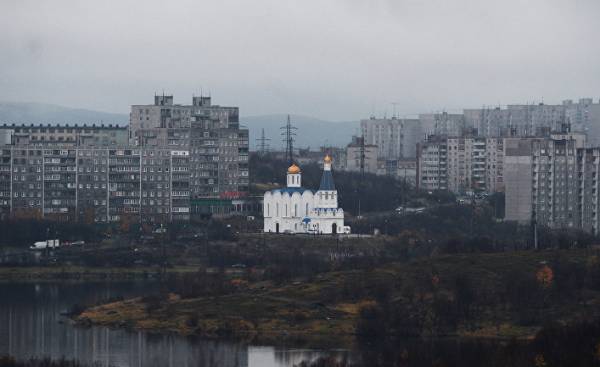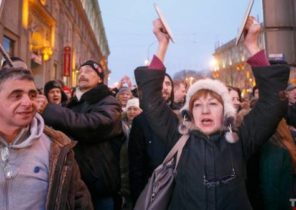
Visitors to the Museum on the nuclear icebreaker “Lenin” treading water in a mess of melting snow and melt water at the dock in Murmansk.
A little further away from the new terminal, commissioned in late March, there are two ships that should go without icebreaker escort between Murmansk and Norilsk, the Arctic mining town that is located more than two thousand miles to the East of Murmansk.
Both — a sign of climate changes that would dramatically change life in the Arctic.
The snow here, 300 kilometres North of the Arctic circle, height in human growth, but the temperature in Murmansk at this time of year is usually lower by 5-10 degrees.
Capricious weather not only creates problems for tourists wishing to explore the Museum-icebreaker “Lenin”, but also opens up new commercial and strategic opportunities — hope in a city that proudly calls himself a “Russian Outpost in the Arctic.”
In Murmansk and other parts of the Russian Arctic expected dividends from global warming that not least applies to the shipping and oil production. At the end of March of a large Russian conference on the Arctic, President Vladimir Putin said in his speech about the positive attitude of Russia to the effects of global warming.
He said that climate change is a factor that largely gave rise to optimism in the country.
He, in particular, pointed to the fact that a warmer climate will facilitate Russia’s oil production in the Arctic and make it cheaper.
Oil and gas now play a big role in the Russian Arctic, where the lives of 2.3 million people, less than 2% of the population, which is bad for the enormous economic weight of the region.
President Putin said that today 10% of the Russian economy are the result of work of the enterprises located in this region, and their share grows constantly.
Enthusiasm
In the port of Murmansk particular interest are opportunities for the growth of cargo at the port, which thanks to the Gulf stream today is free of ice.
“We hope that the warmer weather will encourage the growth of shipping. In recent years, it was his own shadow,” says a former sailor, now retired Vitali Nikiforov, strolling with his grandson about the icebreaker “Lenin”.
He points to another new facility — thanks to him, now here can be moored cruise ships.
At the official level, enthusiastically talking about the new features of navigation along the Northern sea route along the Northern coast of Siberia. If the warming trend continues, the Northern sea route in a few years it will be opened to navigation, at least for eight months of the year.
“In 2022 we will be able to carry on this way up to 40 million tons of cargo, almost 10 times more than in 2014,” — said at a conference in late March, Dmitry Rogozin, Deputy Prime Minister responsible for the Arctic region.
Observers suggest that the expectations associated with navigation on the Northern sea route, up to the present time to implement failed. The best results were achieved in 2013, a year before the start of the economic crisis in Russia, whereas here it took 70 vessels, now that number is less than 20.
To change the dynamics of Russia needs to invest a significant amount to make the route attractive for Western and Asian firms.
“We need a good navigation system, pilotage services and modern icebreakers. On the coast must be created deep-water ports and rail ways in which you can deliver the goods of the enterprises of the Urals and Siberia, which today is other ways”, — said Dmitry Rogozin.
The growth of shipping on this route will give Murmansk and other regions of the Russian Arctic vitamin injections in the form of a raised profit of the shipping companies, but also from related businesses and various services related to shipping.
“The Russians think about the growth of shipping in the Arctic, although it is not yet happening, and this growth requires the modernization and expansion of rescue services and counter-terrorism activities”, — says Christian Saeby Christensen (Kristian Søby Kristensen), senior researcher Centre for military studies University of Copenhagen.
The outflow of population and pollution
Murmansk, the largest city in the world in the Arctic circle, shared hopes and concerns with other areas of the vast Arctic region of Russia. One of the very biggest challenges is the outflow of population from the enormous Arctic region, occupying one-fifth part of the surface of Russia.
In the early 90-ies the population of Murmansk was nearly half a million inhabitants, but then it dropped to 300 thousand. And it will still be reduced. Tens of thousands of people are constantly looking for the opportunity to exchange his apartment in the city for housing in other parts of Russia.
“It’s hard to live here when the polar night lasts for more than two months. Many retirees move to Central Russia, and the young want to leave too”, — said Vitaly Nikiforov.
Much of the infrastructure and residential areas of the city are worn out. More expensive to build here than in other parts of Russia, because you have to import all building materials from other places that are far away.
The Russian budget is heavily loaded military orders and the needs of infrastructure, in particular, in the Crimea, so not much remains for areas North of the Arctic circle.
“In order to make the Arctic a place attractive for human capital from all over Russia needed billions, which is currently in the Treasury not” — indicates Gazeta.ru.
You also need to take into account the delicate ecological balance of the Arctic nature in the planning of the costs of large projects.
“We are dealing with nature, experiencing a heavy load, who grew up in Soviet times, for example, in the form of radioactive waste left by the military,” says Ildar Neverov, environmental public organization “Business Russia”.
Thus, experts have no absolute unity in opinions about whether climate change is, ultimately, useful for Russia or hurt its development.
“Climate change is a favorable factor for the Russian Arctic, it opens a lot of opportunities, especially in connection with the Northern sea route, says Jon.-Clemmensen (Jon Rahbek-Clemmensen), a specialist in the Arctic, University of southern Denmark. But they are a disadvantage for non-Arctic areas of Russia, and this disadvantage is presumably more than the advantages in the Arctic.”







